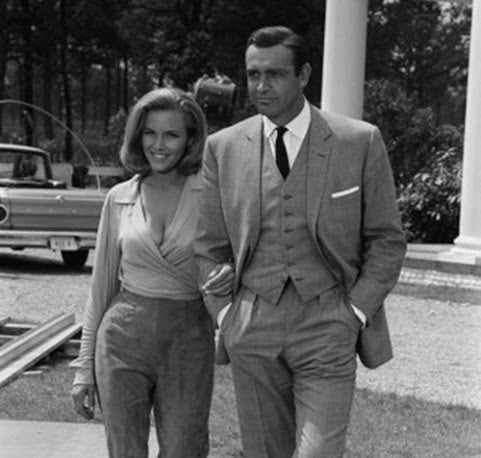The Prince of Wales Check: A Pattern with Character
Posted: Jun 09 2016
 Like chefs who are inspired by delicious ingredients, as tailors, we are inspired by the exceptional fabrics that make up our bespoke suits. As far as textiles go, most people know the classic hounds tooth, pinstripe, and gingham. But one pattern, which has a bit more backstory and a wonderful look, is Prince of Wales check. Check out our guide to this fascinating fabric...
Like chefs who are inspired by delicious ingredients, as tailors, we are inspired by the exceptional fabrics that make up our bespoke suits. As far as textiles go, most people know the classic hounds tooth, pinstripe, and gingham. But one pattern, which has a bit more backstory and a wonderful look, is Prince of Wales check. Check out our guide to this fascinating fabric...
The Name
Nicknamed after the Prince of Wales (later known as Edward VII) who famously popularized the check, The Prince of Wales check is also known as glen check, glen plaid (in the US) and Glen Urquhart check. Although nowadays the terms are used interchangeably, it takes a trained eye and a true tailoring aficionado to know the subtle differences and understand the complex, yet fascinating history behind the two. Allow us to give you the 101…
 The History
The History
Dating back to the early 19th century, the glen check was first developed by the Countess of Seafield in the valley of Glenurquhart in Invernesshire, Scotland as the Seafield estate’s signature tweed. It was here that The Prince of Wales, who often went shooting at the estate, discovered and borrowed the check to make his own variation. It was then further popularized stateside by his stylish grandson, the Duke of Windsor (formerly known as Edward VIII, of abdication fame.)
The Look
The pattern is made up of two dark and two light stripes alternating with four dark and four light stripes to create a crossing pattern of irregular checks. The Seafield estate’s original glen check featured a woven twill in a repeated pattern of large broken checks in shades of black and grey and was considered highly inventive at the time. The Prince of Wales first adapted the check by simply changing the colors to brown and cream. As he continued to adjust the check, he later went on to shrink it down to the smaller size that is better known today. The Duke of Windsor followed in the footsteps of his well-dressed grandfather and made his own modifications by boldly adding overchecks in red and blue.

Nowadays, the names glen check and Prince of Wales check can be used to refer to any textile with the distinctive box-like graphic pattern of both original styles in muted colors and a smaller scale… resulting in a fabric that is simultaneously classic and contemporary. The outcome: a dashing modern look with an undeniably sophisticated European tone.
The Icons
 There is no doubt that the Duke of Windsor was quickly established as a style icon thanks to his daring tailoring instincts, his avant-garde pattern play, and, of course, his unquestionably dapper Prince of Wales suits. Yet while the fabric has royal origins, it continues to make a splash in pop culture to this day. It has been regularly featured in the James Bond films, from Sean Connery to Daniel Craig, and stars from Ronald Reagan and to Pee-Wee Herman have made bold statements on camera decked out in the Prince of Wales check. As an everlasting favorite among the best on Savile Row and thanks to contemporary designs from renowned menswear designers such a Ralph Lauren and Tom Ford, glen check and Prince of Wales checks still make an impactful appearance in fashion editorials and on red carpets worldwide.
There is no doubt that the Duke of Windsor was quickly established as a style icon thanks to his daring tailoring instincts, his avant-garde pattern play, and, of course, his unquestionably dapper Prince of Wales suits. Yet while the fabric has royal origins, it continues to make a splash in pop culture to this day. It has been regularly featured in the James Bond films, from Sean Connery to Daniel Craig, and stars from Ronald Reagan and to Pee-Wee Herman have made bold statements on camera decked out in the Prince of Wales check. As an everlasting favorite among the best on Savile Row and thanks to contemporary designs from renowned menswear designers such a Ralph Lauren and Tom Ford, glen check and Prince of Wales checks still make an impactful appearance in fashion editorials and on red carpets worldwide.
At Tailor On Ten, we are obsessed with the details and the stories that bring our materials to life. A perfect suit is an intricate balance of flavors to suit the taste of the wearer. The Prince of Wales check as a pattern achieves that balance; subtle enough not to be too loud, yet distinctive enough not to be boring. We stock some wonderful Prince of Wales checks, with some all time favorites from Dormeuil, Giovanni Tonella and Vitale Barberis Canonico. Check them out for a guaranteed shortcut to feel as debonair as the Duke of Windsor and as effortlessly cool as Sean Connery’s James Bond (and for more on that style icon, click here).












